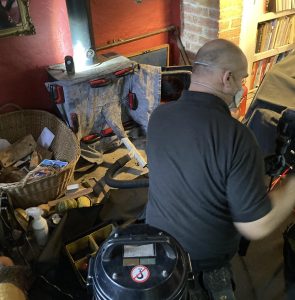 I thought for this week’s blog I would write another one about us working. On this occasion I have chosen one of our regular biannual jobs at a thatched cottage in Radwinter. Here we are sweeping a Stovax Stockton boiler stove. By their very nature and construction, boiler stoves have a tendency to tick-over and therefore create a large quantity of crusty tar in the chimney – A job for rotary power sweeping. Rotary power sweeping being the most effective sweeping method for removing resistant tar from the chimney.
I thought for this week’s blog I would write another one about us working. On this occasion I have chosen one of our regular biannual jobs at a thatched cottage in Radwinter. Here we are sweeping a Stovax Stockton boiler stove. By their very nature and construction, boiler stoves have a tendency to tick-over and therefore create a large quantity of crusty tar in the chimney – A job for rotary power sweeping. Rotary power sweeping being the most effective sweeping method for removing resistant tar from the chimney.
Power or rotary sweeping relies on the use of a drill to turn rod that click or button lock together and which turn very quickly – A variety of different sweeping heads can be used with power rods, including various nylon stranded heads, various metal cable/strands, brushes or even chains for cleaning tarry terracotta liners. Power sweeping is very effective for cleaning stubborn tar deposits, chimneys with tight turns, or stripping out bird’s nests. However, it should not be used on chimneys made of old soft red brick, old clay pargeted chimneys or brick chimneys that are in a poor state of repair, as it is far too vigorous a method of sweeping and would cause damage to the chimney. This said many sweeps that are out there in your area are only equipped and trained to use the power sweeping technique. Clearly, by definition such sweeps are not the real deal and are not equipped or trained to deal properly with everything that is out there – In my view all sweeps should be properly accredited and there should be a requirement for them have passed the NVQ and be on a list of nationally accredited sweeps.


 My name is Paddy McKeown, I am a retired police officer (Detective Sergeant – Metropolitan Police), turned chimney sweep. I have completed training with ‘The Guild of Master Chimney Sweeps’, and Rod Tech UK (Power Sweeping).
My name is Paddy McKeown, I am a retired police officer (Detective Sergeant – Metropolitan Police), turned chimney sweep. I have completed training with ‘The Guild of Master Chimney Sweeps’, and Rod Tech UK (Power Sweeping).




Comments are closed.